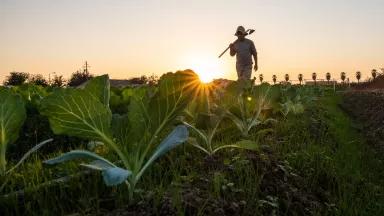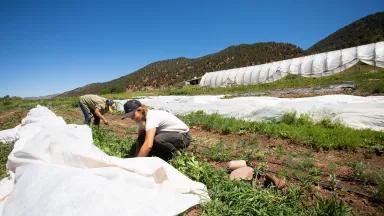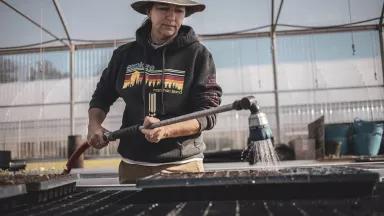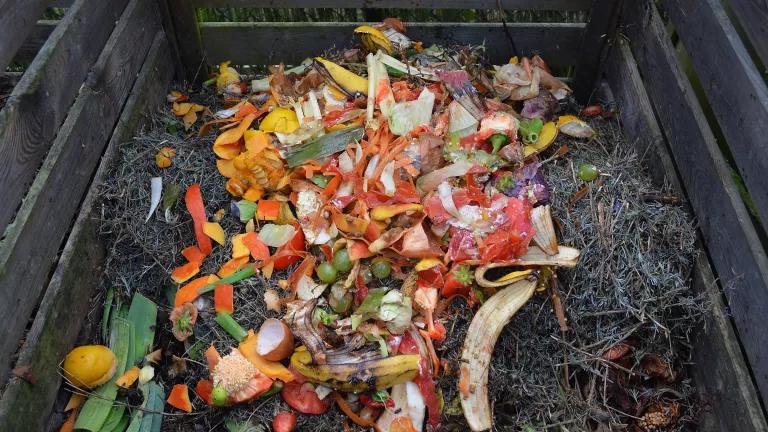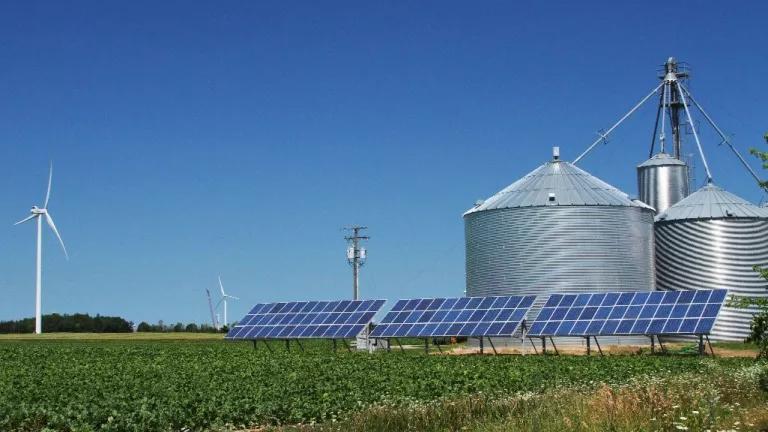Opportunities in Organic Enhance Climate Resilience
A new GAO report on climate resilience in agriculture overlooks a solution that is already at our fingertips: investing in organic agriculture.
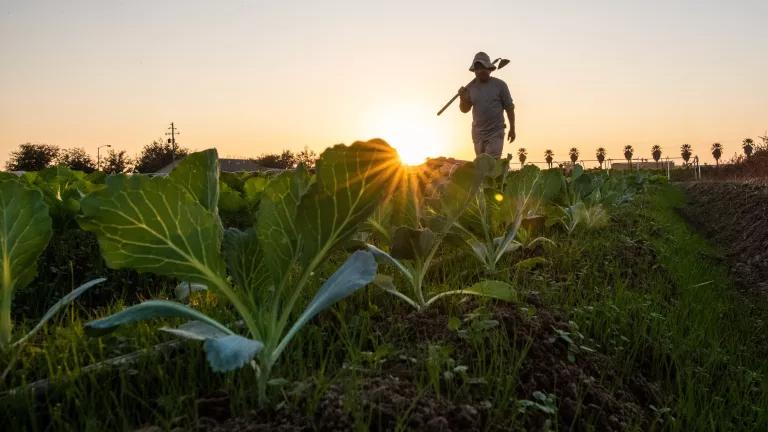
A Government Accountability Office (GAO) report to Congress identifies 13 options to enhance climate resilience in agriculture—but it overlooks a solution that is already at our fingertips: investing in organic agriculture.
Our recent report, Grow Organic, highlights the well-documented resilience benefits of organic farming systems (and we’ll talk through these benefits and other benefits of organic in our upcoming Grow Organic briefing). Organic management practices boost soil’s ability to absorb and retain water and the natural nutrients that make soil healthy, which leads to improved yields and stability, especially during times of climatic stress. For example, more than 40 years of studies by the Rodale Institute, comparing crops grown in organic and conventional systems, show that after a five-year transition period organic yields are competitive with conventional yields—and in times of extreme weather, organic yields are up to 30 percent greater. In addition, organic crops produced without synthetic fertilizers that accelerate growth may develop stronger cell membranes and higher levels of polyphenols and antioxidants that protect plants from stress (and which are also important for human health).
As climate conditions become increasingly volatile, organic farming—including growing diverse crops in rotation, integrating animals into operations, prioritizing soil health, foregoing the use of fossil fuel-intensive inputs, and supporting biodiversity—provides a natural insurance policy against crop failure.
The GAO report outlines important levers that the U.S. Department of Agriculture (USDA) could use to enhance climate resilience, including expanding relevant technical assistance; growing conservation programs and aligning them with climate needs; and linking farm eligibility for public funding with the adoption of climate-resilience practices.
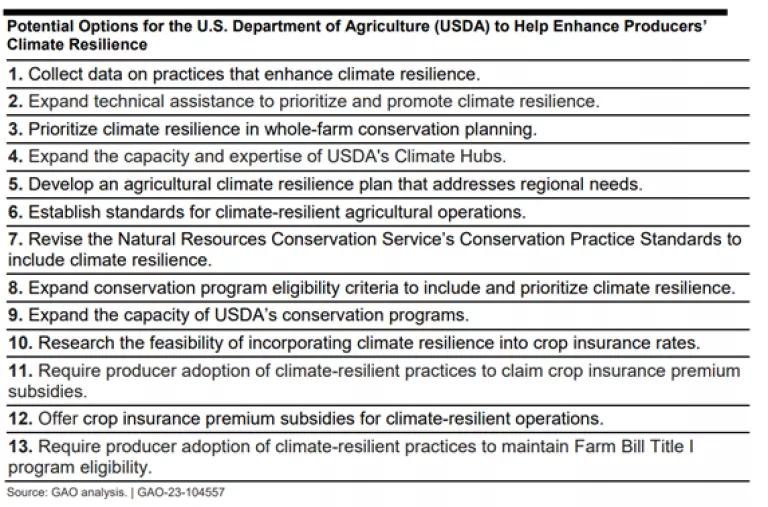
Government Accountability Office
Importantly, the report recognizes that using these levers together will deliver the most meaningful results. Similarly, the USDA should ensure that it implements these options in ways that directly support time-tested solutions, including the agency’s own investments in organic agriculture.
A first step: The USDA Organic Transition Initiative
The USDA has already initiated a multiprong approach to promote the resilience benefits of organic with its $300 million Organic Transition Initiative. The Initiative launched a six-region Transition to Organic Partnership Program that will fund a wide range of activities and mentorship opportunities that help producers successfully transition to organic. The initiative will also make it easier for certified organic and transitioning producers to access funding through Farm Bill conservation programs, and it will provide resources for market development in undersupported organic sectors, including grains and processing.
Rather than looking to organic as an example of how to create new resilience standards and programs—as the GAO report suggests—the USDA and Congress need to double (or triple or quadruple) down on investments in organic, to ensure that anyone who wants to farm or eat organically, can do so.
What’s next: We need comprehensive support for organic
Several existing Farm Bill programs support organic agriculture, transition, and research, but they fall far short of the holistic and integrated investments in organic that we need to prepare our food and farming systems for the future.
Organic certification costs and processes remain a barrier for many farmers and ranchers, and most producers have limited access to organic-specific technical assistance or mentorship—especially in regions with smaller organic sectors like the Southeast.
Many producers of color and beginning, smaller scale, and limited resource farmers and ranchers also face unique barriers that further limit their ability to transition to organic. This includes lack of access to regionally and culturally relevant technical assistance, land access challenges, and thin fiscal margins that make any risk—including exploring new markets or testing new practices—difficult to bear. Mistrust of the USDA due to longstanding patterns of discrimination exacerbates these challenges.
In addition, as agriculture adapts to changing market conditions and weather patterns, producers need new and flexible resources to help them successfully transition to and maintain organic farming and ranching systems.
The long game: Farm Bill opportunities for organic
The USDA’s Organic Transition Initiative is building new vital partnerships and strengthening relationships between farmers, ranchers, and the organizations and institutions they trust to deliver support across the country quickly and effectively.
We have a chance to make these types of investments and their resilience benefits permanent in the 2023 Farm Bill, by revamping the existing National Organic Certification Cost-Share Program (which reimburses a portion of certification costs) into a comprehensive program that also includes organic transition support and technical assistance. Such a redesigned program should offer a suite of flexible, easy to access tools to reduce barriers to organic agriculture and ensure no farmer or rancher is left out of organic because they can’t afford certification.
The program needs three core components to succeed, which closely align with the resilience options outlined by the GAO:
- Organic certification cost-share update
- Cost-share payments that cover 100 percent of certification costs, up to $1,500 per scope.
- USDA discretion to exceed that cap, to ensure that certification costs are not a barrier to certification for underserved producers and regions.
- Transition and resilience fund
- Flexible funding for organizations to support organic transition, particularly for smaller scale producers, producers of color, and underserved regions; these organizations may provide a wide range of services, including culturally and regionally relevant assistance with the certification process and record-keeping, inspector training, and mentorship programs.
- Flexible funding for producers to offset costs and reduce barriers associated with the transition process, ranging from learning new farming and ranching techniques to business planning, equipment, and on-farm infrastructure.
- Technical assistance
- New resources for organic-relevant technical expertise, capacity, and partnerships at public institutions and organizations, including support for education, outreach, and market expansion, so producers in any part of the country will have access to professional assistance, to build healthy soil, manage pests naturally, and protect natural resources.
As society grapples with multiple looming crises, including climate change, public health threats, and struggling economies, we can’t afford to look at any problem through a single lens. Organic producers increase resilience in our food supply while also reducing the climate footprint of food production and protecting the health of our food and farming system and the people and resources that make it work. We urgently need to reward organic farmers and ranchers for their efforts and entice more to join them, and many of the options identified in the GAO report will help. Congress should ensure that the next Farm Bill delivers the USDA the resources it needs to build more opportunities in organic.


